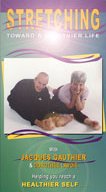Yoga-Related Injuries Already High and Rising:
How You Can Prevent the Casualties of Yoga
by www.SixWise.com
Yoga is enjoyed by at least 18 million Americans, according
to the May 2006 issue of U.S. News & World Report. People
swear by this increasingly popular pastime to relieve stress,
tone their bodies, increase their energy and more.
But as with most things in life, the benefits do not come
without a risk.
In 2006, there were 4,459 yoga-related injuries in the United
States, a report by the U.S. Consumer Product Safety Commission
found.
|

Most yoga injuries occur from repetitive strains and
overstretching.
|
Ironically, the very same things that provide your body the
benefits -- the stretching, holding, balancing and flexing
-- can also lead to injury if you try to do too much, too
quickly.
The most common injuries related to yoga, according to the
American Academy of Orthopaedic Surgeons (AAOS), are caused
by repetitive strain to and overstretching of your:
-
Neck
-
Shoulders
-
Spine
-
Legs and knees
While many injuries are minor, they can be severe, leading
to serious back injury or requiring surgery. The faster-paced
yoga varieties and Bikram, which is done in a hot room that
increases your flexibility (and may make you stretch farther
than you should), are especially risky.
And as yoga enthusiasts continue to grow in numbers, so too
will the prevalence of injuries.
Preventing Yoga-Related Injuries
Yoga is a process that is founded on rhythm, flow and patience.
If you buck these principles -- for example the Baby Boomer
who attends the "advanced" class before mastering
the "beginner" one, or the young convert who is
too eager to try difficult positions -- you increase your
risk of getting hurt.
|
Daily Stretches for Your Flexibility
 Like
yoga, stretching can reduce stress, increase your blood
circulation and more. When used together, stretching
and yoga offer a synergistic effect that enhances your
benefits from both, and can actually reduce your risk
of yoga-related injuries. Like
yoga, stretching can reduce stress, increase your blood
circulation and more. When used together, stretching
and yoga offer a synergistic effect that enhances your
benefits from both, and can actually reduce your risk
of yoga-related injuries.
How? Because stretching is a safe way to increase your
flexibility, and flexible muscles are not as likely
to become injured from extended movements, such as those
done in yoga.
For 15 stretches that stretch all the key muscles groups
throughout your entire body -- and that take just 15-20
minutes per day to complete -- Sixwise.com highly recommends
the Stretching Toward a Healthier Life DVD.
Find
Out More and Order the Stretching Toward a Healthier
Life DVD Now!
For a Limited
Time, Get FREE SHIPPING!
|
The number one way to prevent injury while practicing yoga,
or any other type of physical activity, is to start slowly
and work your way up gradually. You should feel you're being
challenged, but your body should not be in pain. If it is,
you need to back off immediately.
You can also protect yourself during a yoga session by:
-
Finding a qualified instructor. You should not
attempt to do yoga on your own until a knowledgeable teacher
has taught you at least the basics. Yoga instruction is
not regulated in the United States, so be sure to ask
your potential instructor where he or she was trained,
what experience they have and even for a few referrals.
-
If you're a beginner,
start out very slowly. Learn the basic poses, but
focus on picking up the breathing techniques rather than
trying to stretch too far.
-
Warm up before class. You should warm up by jogging
in place, doing jumping jacks or other vigorous activity
to warm up your muscles, tendons and ligaments.
-
Stretch regularly. Stretching will help increase
your flexibility, reduce muscle tension, improve your
circulation and help prevent injuries if you do it on
a regular basis. For an excellent stretching routine that
takes just 15-20 minutes a day, check out the Stretching
Toward a Healthier Life DVD.
-
Learn about the different
types of yoga. Some are fast-paced and strenuous
while others are more gentle and relaxing. Choose your
yoga type according to your fitness level and purpose.
-
Tell your instructor about any medical conditions
you have. He or she can tell you what precautions
to take if you have back problems, high blood pressure,
a knee injury or other conditions that may be impacted
by yoga.
|

If you're new to yoga, make sure you learn the basics
from a qualified instructor before moving forward.
|
-
Wear loose, comfortable clothing. Tight, stiff
clothing can restrict your movements.
-
Listen to your body. If something feels too hard
or painful, don't do it. If you're unsure of how to do
a pose, ask your instructor for help before trying it
out.
Finally, remember that millions of people practice yoga safely,
without injury, every year. If you start gradually, progress
slowly and always listen to your body, your risks are minimal.
According to AAOS, "The rewards of basic yoga outweigh
the potential physical risks, as long as you take caution
and perform the exercises in moderation, according to your
individual flexibility level."
Related Articles
The
Nine Best Exercises for You if You Have Aching Joints
The
Seven Most Dangerous Common Weight-Lifting Exercises and How
to Do Them Properly
Sources
The
American Academy of Orthpaedic Surgeons
ChicagoTribune.com
October 30, 2007